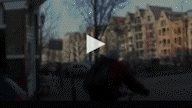The Hollandsche Schouwburg (Dutch Theater), where the Jews of Amsterdam had to report themselfs prior to their deportation to the Westerbork transit camp.
Opposite of the Hollandsche Schouwburg on the Plantage Middenlaan, there was a nursery. The nazis put the young children there in stead of in the theater. The Dutch set up a system to rescue children via the nursery. Children were secretly brought to Reformed Teacher Training College, two houses from the theater. They got there through the garden.
From there the children went into a backpack, shopping bag or laundry basket to be transported to Limburg and Friesland by train and tram. The children were not registered and removed their names from the records of the theater. Thanks to this plan about 600 children could be saved.
















































